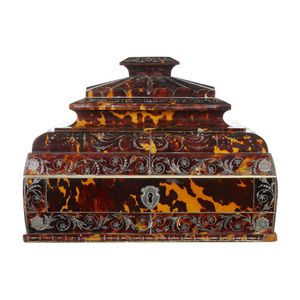Anglo-Portugese Silver Writing Box with Pagoda Top
A pagoda topped Anglo-Portugese silver inlaid pique work writing box, the red Moroccan Floretine stamped leather interior lined in ivory and quilted blue silk. Portugese circa 1800. 22 x 30.5 x 25 cm
You must be a subscriber, and be logged in to view price and dealer details.
Subscribe Now to view actual auction price for this item
When you subscribe, you have the option of setting the currency in which to display prices to $Au, $US, $NZ or Stg.
This item has been sold, and the description, image and price are for reference purposes only.
- Pique Work - A decorative technique used on jewellery and small decorative objects in which designs are created by inlaying small gold or silver studs and stips into tortoiseshell. The art reached its highest point in 17th- and 18th-century France, particularly for the decoration of small tortoiseshell articles such as combs, patch boxes, and snuffboxes.
- Ivory - Ivory is a hard white material that comes from the tusks of elephants, mammoth, walrus and boar, or from the teeth of hippopotamus and whales. The ivory from the African elephant is the most prized source of ivory. Although the mammoth is extinct, tusks are still being unearthed in Russia and offered for sale.
Ivory has been used since the earliest times as a material for sculpture of small items, both in Europe and the east, principally China and Japan.
In Asia ivory has been carved for netsuke, seals, okimono, card cases, fan supports, animals and other figures and even as carved tusks.
In the last 200 years in Europe ivory has been used to carve figures, for elaborate tankards, snuff boxes, cane handles, embroidery and sewing accessories, in jewellery and as inlay on furniture. Its more practical uses include being used for billiard balls, buttons, and a veneers on the top of piano keys.
The use and trade of elephant ivory have become controversial because they have contributed to Due to the decline in elephant populations because of the trade in ivory, the Asian elephant was placed on Appendix One of the Convention on International Trade in Endangered Species (CITES), in 1975, and in January 1990, the African elephant was similarly listed. Under Appendix One, international trade in Asian or African elephant ivory between member countries is forbidden. Unlike trade in elephant tusks, trade in mammoth tusks is legal.
Since the invention of plastics, there have been many attempts to create an artificial ivory - Circa - A Latin term meaning 'about', often used in the antique trade to give an approximate date for the piece, usually considered to be five years on either side of the circa year. Thus, circa 1900 means the piece was made about 1900, probably between 1895 and 1905. The expression is sometimes abbreviated to c.1900.
This item has been included into following indexes:
- boxes, material or decoration
- pique work inlay - other small items 45
Visually similar items

World War II Japanese type 98 (1938) Summer uniform with brown officers boots, Puttees and Gators
Sold by
in
for
You can display prices in $Au, $US, $NZ or Stg.

A ruby and diamond ring, oval chequerboard cut ruby approx 21.25cts, diamond set shoulders; 14ct gold. Weight 8.9g.
Sold by
in
for
You can display prices in $Au, $US, $NZ or Stg.

A jade and diamond dress ring. Platinum.
Sold by
in
for
You can display prices in $Au, $US, $NZ or Stg.

A Sevres pattern porcelain wall plaque painted with the named portraits of nobility 50 cm diameter
Sold by
in
for
You can display prices in $Au, $US, $NZ or Stg.
